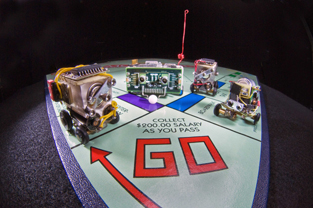The Smithsonian Institution has agreed to obtain nine robots which are part of Sandia Lab’s historically significant robotic collection. These robots would be placed at the National Museum of American History.
 Miniature autonomous robotic vehicles were developed in the mid-1990s and led to the creation of superminiature robots in 2001, which were selected by Time magazine as the invention of the year in robotics in 2001
Miniature autonomous robotic vehicles were developed in the mid-1990s and led to the creation of superminiature robots in 2001, which were selected by Time magazine as the invention of the year in robotics in 2001
Philip Heerman, Senior Manager of Sandia’s Intelligent Systems, Robotics and Cybernetics, regarded the Smithsonian request for Sandia’s collections as a way of recognising the contribution of Sandia to the nation. Earlier this year, Ray Byrne from Sandia was contacted by a curator from Smithsonian curator for obtaining the MARV (Miniature Autonomous Robotic Vehicles) robots, which hold the honor of being among the first miniscule robots in the US during the mid-1990’s. The MARV robots were compact occupying a space less than one cubic inch and contained all the necessary power, sensors, controls and computing devices within this space. Barry Spletzer, a retired robotic scientist from Sandia and the creator of MARV, explained the significance of MARV robots as being the first of its kind in the field of robotics.
Byrne mentioned that they have donated the MARV robots, Dixie, the first battle field scout robot, SIR, one of the first completely autonomous interior robots, super-miniature robots and the hopping robots to Smithsonian so far. The Scandia Interior Robot (SIR) was introduced in 1985, at that time it was the only robot that could find its way out of a building without the help of a previously programmed route or floor wiring. SIR was extremely useful in executing hazardous tasks such as getting rid of radioactive waste or acquiring knowledge required for armed forces deployment in hostile areas. Dixie, introduced in 1987, was an all-terrain vehicle capable of performing reconnaissance missions. Dixie makes use of teleoperation with superior navigation features to enable a remote operator to evaluate the nearby terrain. The hopping robots, introduced in 2000, were capable of hopping 20 feet in the air clearing obstacles like walls. It was the first robot to be powered by a combustion cylinder and a piston foot and could be used for planetary exploration, military intelligence and to assist police during surveillance or standoff operations.The superminiature robots, introduced in 2001 were descendants of MARV, they were less than a quarter of a cubic inch and could wriggle through pipes to look for chemical plumes or presence of humans.These robots could include improvements such as microphones, miniature cameras, chemical microsensors and communication devices. They had the ability to interact with each other and work in collaboration very much like insects. Finally, the NETBOTS, which were of the size of a remote controlled toy car useful in military operations that required images or data to be exchanged amongst the NETBOTS.